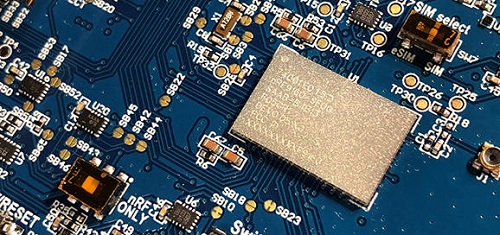By Richard Quinnell, editor-in-chief
For IoT devices that remain fixed in place or are confined to relatively small spaces, a local area network like Wi-Fi or ZigBee provides adequate connectivity. But if the device needs to remain connected while roaming over hill and dale, or even from continent to continent, there have been few good choices. A compact system-in-package (SiP) from Nordic Semiconductor intends to change that situation, however, by bringing multimode LTE-M NB-IoT cellular connectivity to power-constrained IoT device designs.
Cellular technology has become so pervasive that there are more active cellphones in the world than there are people, and it has been this way for several years. So it’s only natural that developers of IoT devices that need to operate within a large geographic area have been looking at cellular as a wide-area connectivity option for some time. But factors such as the power demands, size, and cost of cellular transceivers have been an impediment to the implementation of cellular IoT.
The nRF91 series modules recently demonstrated in Oslo promise to change that and bring cellular data connectivity to the broad IoT market. The SiP integrates a complete low-power cellular IoT system into a tiny 10 x 16 x 1.2-mm package that integrates modem, transceiver, RF front end, dedicated application processor, Flash memory, power management, crystal, and passive components while eliminating the need for surface acoustic wave (SAW) filters for precision frequency selectivity.

The module will come with complete regulatory and cellular certification, so developers can essentially drop the module into their design and be confident that it will meet government and service provider requirements for connecting to regional networks almost anywhere in the world. A multi-mode design based on Nordic’s SAW-less transceiver and a custom RF front end from Qorvo allows the SiP to accommodate country-specific variations in wireless standards. The demonstration, for instance, had the device working on the Verizon Wireless network of the U.S. and the Telia network of Norway.
The device’s processor is based on the ARM Cortex-M33 with TrustZone CryptoCell-310 security technology, providing developers with a powerful and secure platform on which to run their application code. This will help to ensure that the user’s data is kept secure and that the device hardware and code are hack-resistant. It also helps eliminate the cost, power, and size penalties of a second application processor; the ARM core is powerful enough to run both the communications protocols and the user code.
Along with its small size, the module promises low-power operation that maximizes battery life. Power consumption and data rates are inversely related, but at its maximum rate of 360 kbps, the device will consume only about 150 mA, the company claimed in its “sneak-peek” presentation. It also pointed out that the device, when transmitting data every 20 seconds, would run on batteries for six months and could provide up to 15 years of battery life when set to connect only every 10 minutes.
While the device is not yet generally available for most IoT developers, it should be soon. Nordic has been delivering samples to lead customers since December and expects to start general sampling by mid-2018. Production quantities, with full production-ready software and certifications, should be ready by the end of the year.
Advertisement
Learn more about Electronic Products Magazine





